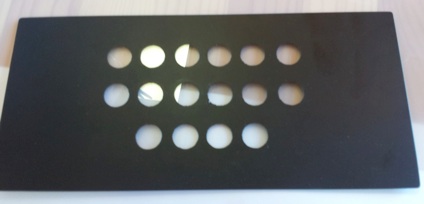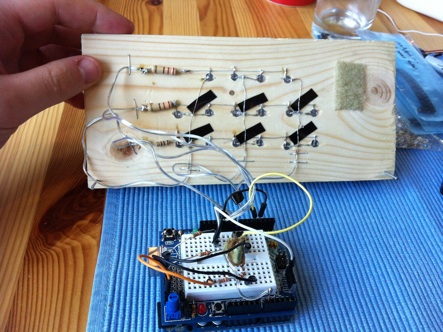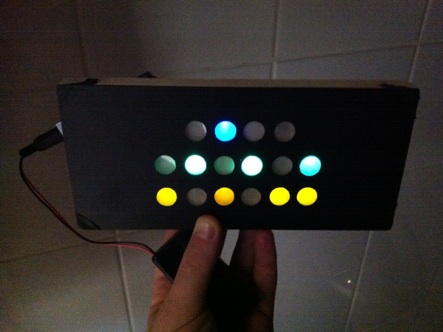I made this as a fun ‘practice clock’ so I wouldn’t get any unpleasant surprises when I worked
on the larger Word Clock. I’ve seen a few binary clocks on sale before, but they all use a
pseudo-binary readout with six vertical columns of LEDs, one column for each decimal digit. My
clock here mimics a six-digit decimal clock more closely, in that the hours, minutes, and
seconds are each one number from 00 to 59 (or 01 to 12 for the hours). Like the word clock, it
has a painted glass front, wooden back, and is run by an Arduino. Below is an (upside down)
picture of the front glass plate.
 The top (bottom of the picture) four dots are for the hours, the middle are minutes, and bottom
are seconds. Only six digits are necessary for each, as 111111 in binary equals 63. The highest
number the clock displays is 111011.
The top (bottom of the picture) four dots are for the hours, the middle are minutes, and bottom
are seconds. Only six digits are necessary for each, as 111111 in binary equals 63. The highest
number the clock displays is 111011.
 Here’s a view of the inside. It’s not pretty, but it doesn’t need to be. The white circles are
pieces of “diffusing” plastic, glued to the glass.
Here’s a view of the inside. It’s not pretty, but it doesn’t need to be. The white circles are
pieces of “diffusing” plastic, glued to the glass.
 Here you can see that the 16 LEDs are multiplexed down to a 3-by-3 array. The lovely little
thing at the bottom is the Arduino UNO with a prototyping shield on top. And below, is a
close-up of the Arduino. The brown blob is a circuit from a cheap alarm clock. It gives out a
small pulse every second, which the Arduino detects and uses to keep time.
Here you can see that the 16 LEDs are multiplexed down to a 3-by-3 array. The lovely little
thing at the bottom is the Arduino UNO with a prototyping shield on top. And below, is a
close-up of the Arduino. The brown blob is a circuit from a cheap alarm clock. It gives out a
small pulse every second, which the Arduino detects and uses to keep time.
 Here’s a nice picture of the finished clock running. The beautiful colors don’t show up as well
in the photo as in real life, but you can see that it reads 4:21:43.
Here’s a nice picture of the finished clock running. The beautiful colors don’t show up as well
in the photo as in real life, but you can see that it reads 4:21:43.
